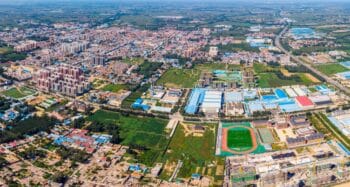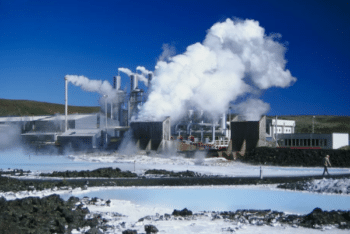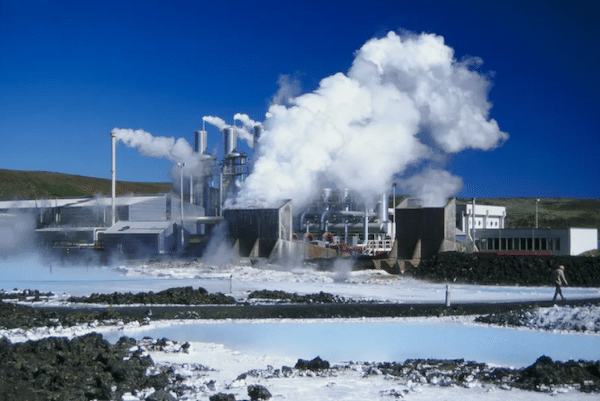China is adopting geothermal because geothermal district heating is by far the most economic means of heating available … It also answers China’s fundamental policy of carbon neutrality and combating air pollution.
City of Xian geothermal district heating
The city of Xian’s geothermal district heating in Shaanxi Province China serves as an example of the country’s decarbonization plans.
China’s commitment that it would strive to peak its carbon dioxide emissions before 2030 and achieve carbon neutrality before 2060 has led a wide-ranging and profound economic and social transformation.
Various levels of government are adopting low-carbon policies tailored to local conditions, and industries are exploring their own green development paths, making concerted efforts to achieve the ambitious goals. This includes green heating, green power and green logistics.
For green heating, geothermal plays a specifically important role, as highlighted by the example of Xi’an, capital of northwest China’s Shaanxi Province. It was a freezing midwinter day in Xi’an, as Zhao Haiyan, 45, wore just a T-shirt and shorts at her home in Lintong, a suburban district of Xi’an as the temperature indoors reached 26 degrees Celsius.

The city of Xi’an’s geothermal district heating in Shaanxi Province, China , serves as an example of the country’s decarbonization plans.
Zhao lives in an affordable housing community of more than 400 households, which is equipped with Lintong’s first zero-carbon and zero-emission clean energy heating project and the first “geothermal+” new energy heating project. Residents were able to enjoy warm green winters as soon as they moved in back in 2018.
Home to the world-renowned terra-cotta warriors, Lintong and the surrounding area have rich geothermal resources. The geothermal heating technology applied in Zhao’s community has been updated to prevent any pollution of underground water reserves, said Wang Chao, director of the Lintong New Area Management Committee.
Statistics from the Shaanxi provincial government show that more than 100,000 households in its central plain area have enjoyed green and clean heating services, and the number is expected to reach at least 600,000 over the next few years, reducing the annual emission of carbon dioxide by 3.6 million tonnes than heating by burning coal.
Utilizing green energy has also brought additional financial benefits. “Based on the 70-square-km urban planning area of the Lintong New Area, comprehensive geothermal energy utilization is expected to create an annual income of about 8.7 billion yuan (about USD 1.37 billion),” said Wang.
China learns from Iceland’s expertise and experience
The geothermal district heating in the province has been developed with Icelandic support as part of Icelandic-Chinese joint venture Sinopec Green Energy Geothermal with the Icelandic partner Arctic Green Energy.
Reykjavik-based Arctic Green Energy is the leading exporter of the Icelandic success and leadership in geothermal to markets around the globe.

The Svartsengi power plant in Iceland was the first geothermal power plant in the world to combine generation of electricity and production of hot water for district heating. (Credit: Kirill Chernyshev/Shutterstock)
Learning from Iceland’s expertise and experience has helped Sinopec Green Energy Geothermal Development, become the world’s largest developer of projects that use underground geothermal energy to heat buildings.
Sinopec Green Energy Geothermal Developmentis is a joint venture between Arctic Green Energy, which owns 46 per cent, and state-owned oil and gas giant China Petrochemical Corporation (Sinopec Group), which owns the remaining 54 per cent.
Haukur Hardarson, chairman of Arctic Green Energy and vice-chairman of the joint venture is quoted by the South China Morning Post (SCMP) as saying:
China is adopting geothermal because geothermal district heating is by far the most economic means of heating available … It also answers China’s fundamental policy of carbon neutrality and combating air pollution.
– SCMP
Unlike fossil fuels, the supply of geothermal energy is highly reliable and is not exposed to volatilities of supply, fuel costs and transport capacity.
China has the world’s largest geothermal district heating network, which spans 200,000 kilometres of pipework and 9 billion square metres of floor space, according to the International Energy Agency. Low operating cost meant it was “very competitive” compared to coal-based heating in the long term.
Sources:
- Thinkgeoenergy, January 11, 2022. arcticgreencorp.com
- SCMP, 3 Sep, 2021. www.scmp.com

